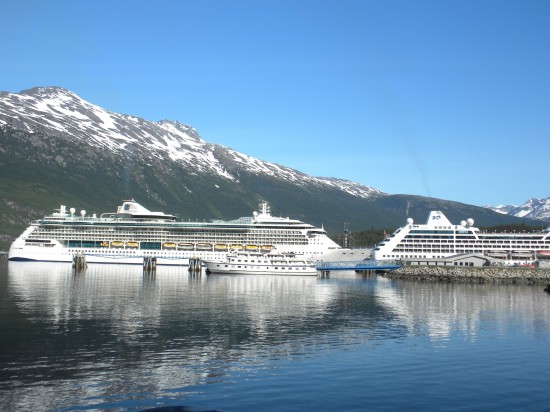
Lynn Canal on the Inside Passage, Alaska. Gilfoto [CC BY 2.0]
My career in the tourism industry began when I boarded an Alaska State Ferry as a 19-year-old college kid, bound for the hamlet of Skagway at the head of the Inside Passage, a thousand miles and three days north of my home in Seattle.
There beneath the jagged peaks that embraced the trails to the Klondike gold fields, I worked a summer job on a sightseeing boat. Each day we made a 120-mile round trip down the Lynn Canal to Juneau and back to Skagway. When the workday was over, we’d hike, fish and hang out on the harbor, which was a pretty quiet place unless we had a “ship day.”
Typically Skagway would see two or three small cruise ships each week, plus a state ferry and maybe a freighter or two. The passenger ships held 600-700 people, enough to keep the tour buses and narrow-gauge railroad and vaudeville shows prosperous for the summer season, while still preserving Skagway’s authentic, rough-around-the-edges feel.
This is now…
What a difference a quarter-century makes. In the 1990s things began to change big-time as industrial tourism exploded in Alaska. No longer ‘The Last Frontier,’ Alaska was discovered by droves of would-be adventurers taking advantage of a booming cruise industry and new hotels sprouting up along the legendary “Alcan Highway” and the outskirts of Denali National Park.

Cruise ships docked in Skagway. As many as five ships a day may call here at the height of the tourist season. Photo credit: Wendy Worrall Redal
Today, Skagway frequently sees five to six cruise ships a day, and they are behemoths, carrying 2,000-3,000 or more passengers each. Ports like Ketchikan, Sitka and Juneau are overrun by throngs from the ships that disgorge their human cargo to step ashore for a few hours of shopping for T-shirts and gold jewelry, much of which you can find from the same purveyors in the Caribbean or Mexico. Many will queue up for bus excursions to see historic totem poles or helicopter flights over glaciers, or a tram ride to the top of Juneau’s Mount Roberts, which was only accessible via a long, steep hike prior to 1996.
Sadly, this has become most visitors’ experience of Alaska. The wild land of legend, the fabled wilderness and wildlife, the challenge of encountering the Northland on its own terms – few travelers know this Alaska anymore.
Some friends of ours returned from an Alaska trip I helped them put together, one that involved renting a car to explore little-known highways and paddling the icy inland waters of Southeast Alaska. The latter is what captured their fancy most, and they can’t wait to get back when they can spend a full week kayaking more isolated reaches.

Saltwater inlet in Misty Fjords National Monument. Photo: Wikimedia Commons.
Away from the big ships, the only sounds are the drip of water from a paddle, the splash of an incoming tide on the rocks and the hollow hum of wind in the spruce forest. Rather than being crammed into staterooms with a few thousand other cruisers, campers share space with bald eagles, black bears, sea lions and whales. And while you’ll find spectacular ice carvings in a shipboard dining room, nothing tops nature’s ice sculptures that are created as blue bergs calve from glacier faces into chilly emerald waters.
Find Authentic Alaska in Misty Fjords
While Glacier Bay is duly famous for wilderness kayaking, Misty Fjords National Monument is even more removed from the big-tourism fray. One of Alaska’s better-kept secrets, Misty Fjords is a 2.3 million-acre wilderness area about the size of Connecticut.
It’s a maze of narrow, jade-green channels hemmed in by 3,000-foot granite walls, waterfalls that plummet in silver ribbons to the sea, streams choked with spawning salmon, and dense old-growth rainforest that shelters brown bears, black bears, Sitka black-tailed deer and wolves. Sea kayaks are the ideal way to explore this roadless expanse, offering eye-to-eye encounters with seals, humpbacks and orcas.
Natural Habitat Expeditions offers a kayaking adventure through the most spectacular section of Misty Fjords, from Winstanley Island at the south end to the natural hot springs at Lake Shelokum in the north. Paddlers explore Shoalwater Pass, Behm Canal and Rudyerd Fjord by kayak, with several hiking options along the way. The steep walls of the fjords protect the water from winds, providing generally calm paddling conditions.
While the shipboard throngs dress for dinner and thrill to a host of singing waiters hoisting flaming Baked Alaska, real explorers throw on a fleece jacket, gather round the flames of a campfire, and and thrill to the howl of a wolf as dusk deepens. That’s Alaska travel, Natural Habitat Expeditions-style.
Won’t you join us in Misty Fjords this summer?
Yours for the peace of the wilderness,
Wendy































